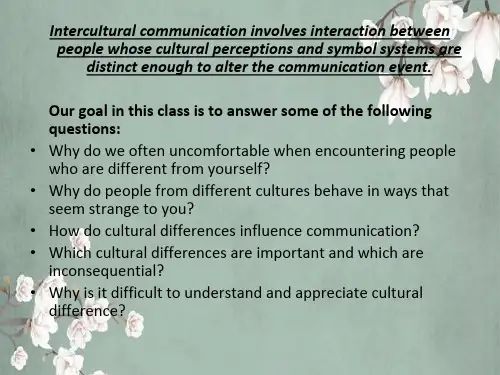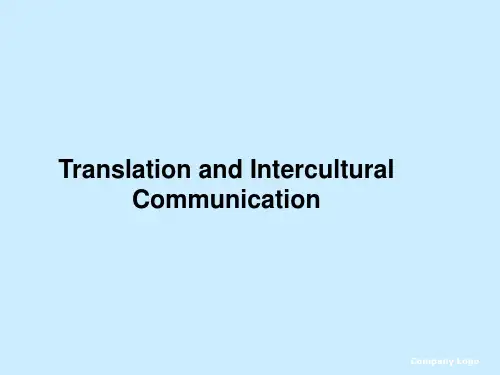跨文化交际实训Chapter1
- 格式:ppt
- 大小:5.90 MB
- 文档页数:12

1、【communication across cultures】Chapter One Conceptual Foundation【跨文化沟通】第一章概念的基础Why study intercultural communication?为什么学习跨文化交际?There is a folk tale that comes to us from the foothills of the Himalayas. A man was trying to explain to a blind friend what colors are. He began with the color White.有一个民间的故事,来自于喜马拉雅山的山麓。
一名男子试图解释一个盲人朋友的颜色是什么。
他开始与雪白的颜色。
“Well,”he said, “it is like snow on the hills.”“嗯,”他说,“这就像雪在山上。
”“Oh,”the blind man said, “then it must be a wet and dampish sort of color, isn’t it? ”“No, no,”the man said, “it is also the same color as cotton or wool. ”“Oh yes, I understand. It must be fluffy color. ”“No, it is also like paper.”“哦,”盲人说,“那一定是湿,微湿的颜色,不是吗?”“不,不,”那人说,“这也是相同的颜色,棉或羊毛。
”“哦,是的,我明白了。
一定是毛茸茸的颜色。
”“不,它也像纸。
”“Then it must be a crackling or fragile color,”said the blind man. “No, not at all. It is also like china.”“那一定是脆皮或脆弱的颜色,”瞎子说。

跨文化Chapter 1P1~2Chapter 1 前三段判断题范围THE ONLY TIME WHEN TRUE SUFFERING OCCURS ISWHEN TWO CULTURES COLLIDE. —— HERMANN HESSE只有苦难发生,当两种文化碰撞时。
anyone who has done business internationally knows that dreadful feeling brought on by the blank stares,任何人做国际业务的都知道,空洞的眼神所带来的可怕感觉,the forced half-smiles, the murmured comments in a language that seems indecipherable—强迫半微笑,用似乎难以辨认的语言低声评论——when what you say doesn't connect, and when something seems missing.当无法和你说什么事情联系上时,有些事情似乎就错过了,The paranoia is inescapable. You had your checklist of cultural do's and don'ts and followed them religiously.偏执是不可避免的。
你有你的该做什么和不该做什么的文化清单,并且虔诚地遵守着。
You broke no taboos, committed no cultural faux pas, insulted no one—yet you failed to break through. Why?你不打破任何禁忌,不犯任何文化失礼,不侮辱任何人——但你却未能突破文化差异。
为什么呢?Distance and time were once the biggest obstacles to doing business internationally.距离和时间,一度成为做国际业务的最大障碍。







Chapter One A Brief IntroductionⅠ. Introduction1. Questionnaires (extra hand-outs)These two questionnaires are presented as the warming up exercises to check how the students can handle communications in daily practice. Discuss the communicative problems with students and analyze the relevant reasons. Then ask the students some questions.2. Lead-in Questionsⅰ. What do you usually communicate with other people?ⅱ. Have you ever been embarrassed when talking with strangers? Why is that?ⅲ. Do you know how to communicate with foreigners?Tell their conversation partner something concrete and significant about themselves.Look for common interests and shared opinions for a more solid basis of relationship.Individualize the foreigners.ⅳ. Have you come across the cultural shock in communication?3. DiscussionDiscuss the different ways of cultural communication and found out the reasons by analyzing some cases.4.Introduction of Intercultural Communicationa.Cross-cultural communication is also called intercultural communication. “Intercultural Communication”is communication between members of different cultural backgrounds. Intercultural Communication involves different perceptions, attitudes, and interpretations. Intercultural Communication is an interdisciplinary field which includes anthropology, cultural studies, psychology, and communication.Anthropology(from the Greek word ἄνθρωπος, "human" or "person") consists of the study of humanity (see genus Homo). It is holistic in two senses: it is concerned with all humans at all times and with all dimensions of humanity. In principle, it isconcerned with all institutions of all societies.Cultural studies combines sociology, social theory, literary theory, media theory, film/video studies, cultural anthropology,philosophy and art history/criticism to study cultural phenomena in industrial societies. Cultural studies researchers often concentrate on how a particular phenomenon relates to matters of ideology, race, social class, and/or gender.Cultural studies concerns itself with the meaning and practices of everyday life. Cultural practices comprise the ways people do particular things (such as watching television, or eating out) in a given culture. Particular meanings attach to the ways people in particular cultures do things.Psychology is an academic and applied field involving the study of the human mind, brain, and behavior. Psychology also refers to the application of such knowledge to various spheres of human activity, including problems of individuals' daily lives and the treatment of mental illness.For instance, if you talk with your American teacher, intercultural communication takes place. If you interact with a Japanese student, there is intercultural communication.It takes place everywhere.Intercultural communication dates back to thousands of years ago. A long time ago, when people started intermingling with each other, when people were having trade relations with each other, there was intercultural communication. A very good example is the Silk Road.b. Reasons for us to learn cross-cultural communication:Modern means of communicationNow jet planes fly everywhere. It used to take a month to travel from Shanghai to Los Angeles. But now, it takes only twelve hours. It is much easier for people to move from one country to another. People of different countries and races get together much oftener than before. Besides, people get in touch with each other in various ways, including the telephone, the internet, the satellite, etc.Sophisticated communication systems have also helped to increase intercultural communication.Global villageThis means multinational companies now operate in many countries in the world.They employ people of different ethnic groups and of different countries.Actually some multinational companies make a point of employing people from different countries. They don't use people from just one country because their company is a multinational company and they want to use people from different countries. People everywhere need to learn about other cultures. They need to know their neighbors. They need to know how to get along with them and how to solve problems that inevitably arise. To do this it is necessary to learn how to communicate across cultures or how to do culture.Mass migrationMillions of people now move across national boarders every year. All these contribute to the fact that intercultural communication is now a daily occurrence.Its importance is now being recognized by an increasing number of people. The United States is a “melting pot”. Many young Americans no longer accept the melting pot image, because it includes the idea that people lose their home cultural identities, traditions, and values when they become Americans. We now replace the melting pot with mosaic. A mosaic is made up of diverse materials or elements that keep their original character when they are combined to create a new design. This new image expresses the idea that part of the American way of life is respect for cultural diversity.c. ApplicationIt can be applied in the training of business executives and technicians, particularly for those who go overseas. And they have to encounter a lot of cultural problems, so they have to be trained before they are sent overseas.Otherwise they would not be able to work effectively.And then there is the training of new immigrants and foreign students. This is done both in the United States, and also in countries like Australia.And then there is multicultural education because at American schools and also at some of the British schools, the pupils, the students are from different ethnic groups, and they have different cultures. So they have to be given what is calledmulticultural education. And also in foreign language teaching, intercultural communication is very important. Finally, it is useful for improving general cultural awareness.Ⅱ. Communication1.Types of Communicationa)human communicationHumans communicate in various ways. We speak, use body languages,intentionally or unintentionally communicate each other in either formal orinformal ways. (formal&informal, oral&written, intentional&unintentional,verbal&nonverbal)b)animal communicationResearchers have discovered that animals share with humans a number ofcharacteristics, including those associated with attraction and mating,territoriality, rivalry and play, familial ties, colony organization, division oflabor, and numbers of other traits that we once assumed were uniquely“human”. (animal language)c)human-animal communicationnon-word soundbody languaged)human-computer communicationInformation that was once conveyed verbally through stories and myths inancient times is now transmitted through high-tech media. (artificiallanguage)e) machine-machine communicationartificial language: codes2. Compare and ContrastGreetingsDialogue 1Friend: Hi, George, have you met Bill?George: No, I haven’t. Hi, Bill.Bill: Hi! How ya doing?Dialogue 2香港人到現在一見面還是會問:“食咗飯未?”意思就是吃過飯了嗎。


Chapter 1 CultureI. Teaching ObjectivesIn this chapter, the teacher should enable the students to:1. understand concepts concerning culture.2. recognize the nature of culture.3. describe the definitions and characteristics of culture.4. discuss about cultural identity and cultural varieties.II. Contents1. Keywords(1) Culture (from intellectual perspective): Culture is “the arts and other manifestations ofhuman intellectual achievement regarded collectively”(从知性角度定义文化:作为整体的人类智力成就的艺术和其他表现。
)(2) Culture (from anthropologic perspective): Culture consists of patterns, explicit and implicit,of and for behavior acquired and transmitted by symbols, constituting the distinctive achievement of human groups, including their embodiments in artifacts; the essential core of culture consists of traditional ideas and especially their attached values”.(从人类学角度定义文化:文化由清晰和模糊的行为模式构成,这些模式通过符号获得并传播,这些符号由人类群体的特别成就构成,包括具体的人工制品。